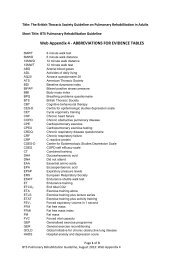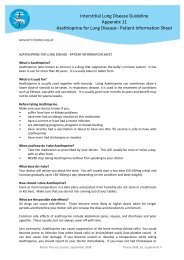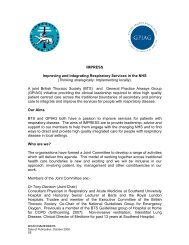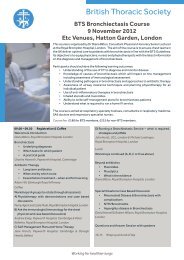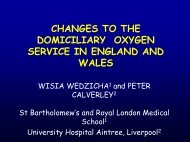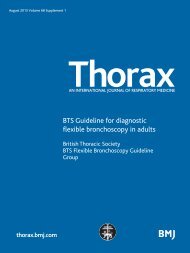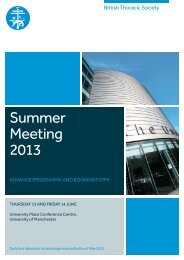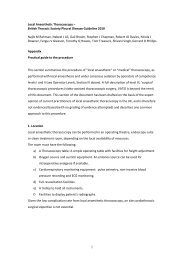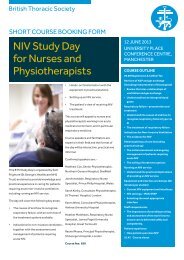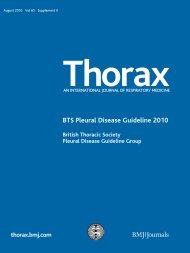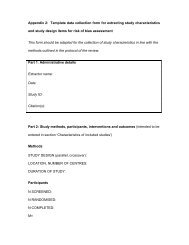Guidelines for the management of community ... - Brit Thoracic
Guidelines for the management of community ... - Brit Thoracic
Guidelines for the management of community ... - Brit Thoracic
Create successful ePaper yourself
Turn your PDF publications into a flip-book with our unique Google optimized e-Paper software.
BTS guidelines<br />
response to parenteral <strong>the</strong>rapy are summarised in box 4. This<br />
policy will allow a significant proportion <strong>of</strong> patients with<br />
pneumonia to be safely transferred to an oral regimen after a<br />
279 372 393 438 476 478 [II] [Ib] [Ia] [II] [Ia] [IVa]<br />
period <strong>of</strong> initial parenteral <strong>the</strong>rapy.<br />
Recommendations<br />
c Patients treated initially with parenteral antibiotics<br />
should be transferred to an oral regimen as soon as<br />
clinical improvement occurs and <strong>the</strong> temperature has<br />
been normal <strong>for</strong> 24 h, providing <strong>the</strong>re is no contraindication<br />
to <strong>the</strong> oral route. Pointers to clinical<br />
improvement are given in box 4. [B+]<br />
c The choice <strong>of</strong> route <strong>of</strong> administration should be<br />
reviewed initially on <strong>the</strong> ‘‘post take’’ round and <strong>the</strong>n<br />
daily. [D]<br />
c Ward pharmacists could play an important role in<br />
facilitating this review by highlighting prescription<br />
charts where parenteral antibiotic <strong>the</strong>rapy continues.<br />
[D]<br />
8.15 Which oral antibiotics are recommended on completion <strong>of</strong><br />
intravenous <strong>the</strong>rapy?<br />
The selection <strong>of</strong> agents <strong>for</strong> oral administration following initial<br />
intravenous <strong>the</strong>rapy is based on antimicrobial spectrum,<br />
efficacy, safety and cost considerations. Although it may appear<br />
logical to select <strong>the</strong> oral <strong>for</strong>mulation <strong>of</strong> a parenteral agent, this is<br />
not essential and such oral agents may not meet <strong>the</strong> criteria <strong>for</strong><br />
selection. For macrolides, oral clarithromycin is better tolerated<br />
than oral erythromycin. 364 365 [Ib] [Ib] A clinical judgement can be<br />
made whe<strong>the</strong>r to change to oral mono<strong>the</strong>rapy in those who<br />
have responded favourably to parenteral combination <strong>the</strong>rapy<br />
or where <strong>the</strong>re is microbiological documentation <strong>of</strong> <strong>the</strong> nature<br />
<strong>of</strong> <strong>the</strong> infection, in which case <strong>the</strong> recommendations in table 6<br />
should be adopted.<br />
Recommendations<br />
c The antibiotic choices <strong>for</strong> <strong>the</strong> switch from intravenous<br />
to oral are straight<strong>for</strong>ward where <strong>the</strong>re are effective<br />
and equivalent oral and parenteral <strong>for</strong>mulations. [C]<br />
c In <strong>the</strong> case <strong>of</strong> parenteral cephalosporins, <strong>the</strong> oral<br />
switch to co-amoxiclav 625 mg three times daily is<br />
recommended ra<strong>the</strong>r than to oral cephalosporins. [D]<br />
c For those treated with benzylpenicillin + lev<strong>of</strong>loxacin,<br />
oral lev<strong>of</strong>loxacin with or without oral amoxicillin<br />
500 mg–1.0 g three times daily is recommended. [D]<br />
8.16 How long should antibiotics be given <strong>for</strong>?<br />
The precise duration <strong>of</strong> antibiotic <strong>the</strong>rapy <strong>for</strong> <strong>the</strong> <strong>management</strong><br />
<strong>of</strong> microbiologically documented and non-documented CAP is<br />
Box 3 Indications <strong>for</strong> parenteral and oral antibiotic <strong>the</strong>rapy<br />
<strong>of</strong> adult CAP<br />
Parenteral <strong>the</strong>rapy<br />
c High severity pneumonia<br />
c Impaired consciousness<br />
c Loss <strong>of</strong> swallowing reflex<br />
c Functional or anatomical reasons <strong>for</strong> malabsorption<br />
Oral <strong>the</strong>rapy<br />
c Community managed<br />
c Hospital managed, non-severe with no o<strong>the</strong>r contraindications<br />
Thorax 2009;64(Suppl III):iii1–iii55. doi:10.1136/thx.2009.121434<br />
not supported by robust evidence. One RCT <strong>of</strong> adults with low<br />
to moderate severity pneumonia treated with amoxicillin<br />
reported similar efficacy with a 3-day intravenous course as<br />
with an 8-day (3 days intravenous followed by 5 days oral)<br />
course. 479 The Summary <strong>of</strong> Product Characteristics (<strong>for</strong>merly <strong>the</strong><br />
Drug Data Sheets) <strong>for</strong> many agents used in <strong>the</strong> treatment <strong>of</strong><br />
CAP mention a range <strong>of</strong> treatment durations which sometimes<br />
differ internationally. Intracellular pathogens responsible <strong>for</strong><br />
pneumonia sometimes respond slowly, and hence a 2-week<br />
treatment regimen has been proposed <strong>for</strong> atypical pathogens.<br />
The aim <strong>of</strong> antibiotic <strong>the</strong>rapy is to ensure elimination <strong>of</strong> <strong>the</strong><br />
target pathogen in <strong>the</strong> shortest time. In uncomplicated<br />
infections this is likely to occur rapidly (within 3 days) with<br />
many common respiratory pathogens such as S pneumoniae. The<br />
resolution <strong>of</strong> pneumonia involves not only <strong>the</strong> elimination <strong>of</strong><br />
<strong>the</strong> invading pathogen and its products, but also <strong>the</strong> subsidence<br />
<strong>of</strong> <strong>the</strong> host inflammatory response which toge<strong>the</strong>r are<br />
responsible <strong>for</strong> <strong>the</strong> many clinical and radiographic features <strong>of</strong><br />
pneumonia.<br />
Until we have more precise methods to reliably identify<br />
microbiological and clinical end-points, <strong>the</strong> duration <strong>of</strong> <strong>the</strong>rapy<br />
will remain subject to clinical judgement. For <strong>the</strong>se reasons, <strong>the</strong><br />
duration <strong>of</strong> <strong>the</strong>rapy will vary by individual patient, disease<br />
severity and speed <strong>of</strong> resolution.<br />
Recommendations<br />
c For <strong>community</strong> managed and <strong>for</strong> most patients<br />
admitted to hospital with low or moderate severity<br />
and uncomplicated pneumonia, 7 days <strong>of</strong> appropriate<br />
antibiotics is recommended. [C]<br />
c For those with high severity microbiologically-undefined<br />
pneumonia, 7–10 days treatment is proposed.<br />
This may need to be extended to 14 or 21 days<br />
according to clinical judgement; <strong>for</strong> example, where S<br />
aureus or Gram-negative enteric bacilli pneumonia is<br />
suspected or confirmed. [C]<br />
8.17 Failure <strong>of</strong> initial empirical <strong>the</strong>rapy<br />
In those patients who fail to respond to initial empirical<br />
<strong>the</strong>rapy, several possibilities need to be considered, <strong>the</strong> first <strong>of</strong><br />
which is whe<strong>the</strong>r <strong>the</strong> correct diagnosis has been made. Clinical<br />
and radiographic review is recommended <strong>for</strong> patients managed<br />
in <strong>the</strong> <strong>community</strong> and in hospital to look <strong>for</strong> secondary<br />
diagnoses or complications <strong>of</strong> CAP such as pleural effusion/<br />
empyema, lung abscess or worsening pneumonic shadowing.<br />
This aspect is considered in detail in Section 9.<br />
The initial empirical antibiotic regimen may need to be<br />
reassessed. However, compliance with and adequate absorption<br />
<strong>of</strong> an oral regimen should first be considered.<br />
Microbiological data should be reviewed and fur<strong>the</strong>r specimens<br />
examined with a view to excluding less common<br />
pathogens such as S aureus, atypical pathogens, Legionella spp,<br />
viruses and Mycobacteria spp. It should also be noted that mixed<br />
infections can arise in approximately 10% <strong>of</strong> patients hospitalised<br />
with CAP. In <strong>the</strong> absence <strong>of</strong> any microbiological indicators<br />
<strong>of</strong> infection, <strong>the</strong> <strong>management</strong> <strong>of</strong> those failing initial empirical<br />
<strong>the</strong>rapy will vary according to <strong>the</strong> severity <strong>of</strong> illness at<br />
reassessment. In patients with low severity pneumonia managed<br />
in <strong>the</strong> <strong>community</strong>, a macrolide could be substituted <strong>for</strong><br />
amoxicillin. However, when <strong>the</strong> patient’s condition has<br />
deteriorated, admission to hospital should be considered.<br />
In <strong>the</strong> patient with low or moderate severity pneumonia<br />
managed in hospital, <strong>the</strong> addition <strong>of</strong> a macrolide is recommended<br />
iii39



